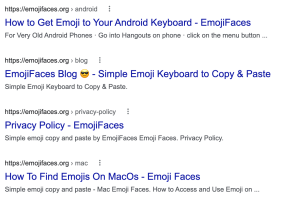Emojis are everywhere these days. They’re used by brands across social media, on billboards and even in television adverts. However, as emojis become more and more commonplace in website meta data, the question remains, are emojis good for SEO?
The party line from Google is that using emojis will neither hurt or help SEO if done in moderation. Using them shouldn’t cause any problems, but you shouldn’t rely on them to make your content stand out. Writing interesting content that’s useful to the reader and is relevant to your website will help improve your SEO ranking much more. However, there are ways to use emojis carefully and make your content more appealing to your users.
Stand out from the crowd
Whilst using emojis in your copy might not make a direct impact on your rankings, they do have other benefits. SEO consultant Amine Dahimene says, “emojis are often used effectively to help listings stand out in the SERPs. And if your listing stands out, this can improve your click-through rate (CTR) and potentially your ranking.” It’s understandable that, in a results page full of text, the listing with an eye-catching emoji in it is bound to look more appealing. But, if something as simple as adding an emoji to a meta title could be enough to improve your CTR, then it’s surely worth a try.

Emojis in title tags
Whilst emojis can be used to make your page stand out, there’s actually no guarantee that any emoji you include will even be displayed. That’s because Google rewrites over 61% of title tags.
It may be that it’s simply cut from the meta data. However, in some cases, Google will replace emojis with the equivalent word. So, if you’re including an emoji in your title tag, make sure its name also fits the context of the sentence. For meta data that includes too many emojis, or emojis that could mislead the reader, Google may just remove them altogether.
How to use emojis properly for SEO
There are certain contexts where an emoji is more likely to be removed or replaced with a word. This includes if it misleads the user, if the emoji is out of context and if it seems to be spamming the user. Using them all the time or relying on them as the foundation of your meta data can only end badly. Think strange-sounding content, lower rankings or a lower CTR.
Instead, use emojis sparingly, and only when they’re relevant. For example, if emojis resonate with your target users and improve the readability of your content. Using them in these contexts can improve your content and increase your website’s trust factor
In conclusion, if including emojis is relevant to your audience and will help increase traffic, then go ahead and use them. However, remember to use them sparingly and only when relevant. After all, the main goal of SEO is usability. Until major search engines release more guidelines on using emojis, or get stricter about when they’re used, only time will tell how large a role emojis have to play in SEO.
